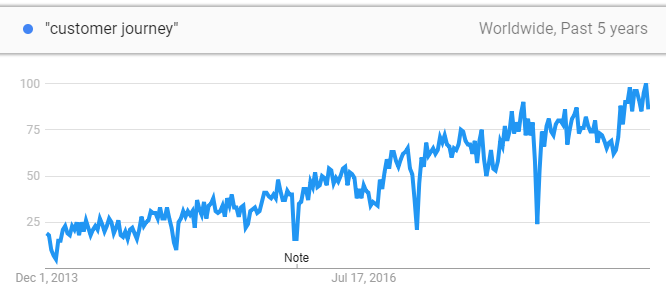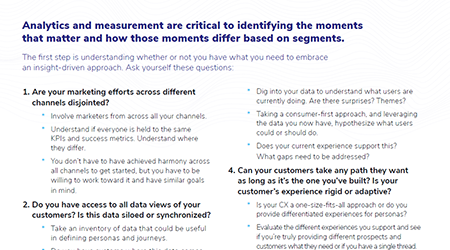Assessing Your Customer Journey Management Maturity

Whether you’ve merely heard the phrase “customer journey” or are actively working to improve and influence your customers’ journeys, our four facets of Customer Journey Management can help you assess how mature your efforts have been and guide your next steps.
Our industry is full of buzzword churn and one of the latest terms currently at its peak is “customer journey.” However, if you peel back the buzz there’s good reason to be talking about customer journeys, and it’s increasingly necessary to step up and focus your efforts in this area.
This image contains Google Trend search results for Customer Journey over the past five years.
For 2018, Forrester estimated $1.8T in cross-channel retail and Macy’s found that customers who shop across multiple channels are eight times more valuable than single-channel shoppers. McorpCX, a customer experience services company, has reported over 50 percent greater return on marketing investments (among other benefits) when you focus on your buyer’s journey. UX expert Kerry Bodine has said that aligning content with your customer’s journey can result in 74 percent more revenue growth.
Based on those numbers and our own experiences, we believe that aligning touchpoints with the Call to Action of our audience (buyers and customers) gives them a means to consistently and effectively engage with us across online and offline channels, thus significantly reducing friction and increasing revenue and loyalty.
Success with journey management doesn’t come easy, nor can you simply jump into machine learning, fully-automated systems that dynamically determine next best actions in the moment. Developing maturity around journey management is, well, a journey in itself. To help navigate this path, we’ve identified four key facets of journey management maturity: Cross-channel Coordination, Customer View, Journey Orchestration, and Content & Path Adaptation.
Cross-Channel Coordination
This is the core discipline of journey management and reflects how well you coordinate across organizational boundaries. This can manifest as customers seeing jarring differences between business units that they interact with for a single, long-running transaction, or as a siloed marketing team where different groups are responsible for different channels and don’t share with each other.
The good news is that a well-crafted experience can hide these silos and make your organization appear seamless to your customers, but even that requires at least some level of collaboration.
Customer View
Between CRMs, order systems, websites, mobile apps, and other channels, there are often numerous, fragmented slices of customer information all over the organization. The discipline of Customer View is about getting a uniform and holistic view of your customers across all of their offline and online interactions so that each part of the organization can make informed decisions.
This does not necessarily require having a master repository serving all systems. There could be an analytics repository or data lake that contains everything, or the different systems could synchronize information that is important to share and collaborate to have the views they need.
There are many tools available to help pull different data views together for further processing that can provide minimal disruption to existing platforms you may have.
Journey Orchestration
The third discipline of Journey Orchestration is around the definition of the journey itself. At the early stages, many journeys are haphazard or created by instinct and managed by hoping for the best. It’s been our experience that there is often already a lot of data available in your digital ecosystem that can be used to better understand who your personas really are and what moments really matter to them. This means maturing in the Customer View discipline can help drive the Journey Definition discipline forward.
It can start simply by using existing site analytics to understand your customers, execute user tests when you design new pieces, and measure results. A deeper dive can be taken with affinity modeling to understand the true personas engaging with your experience and with tools like content-based attribution modeling to find the real moments that matter. With the data in hand, a strong experience design team can make the most out of the information and design journeys that are well aligned with customer needs.
Content & Path Adaptation
You’re on the path to collaborating across silos, you’re getting a better handle on your customer data, and you’re starting to execute a more mindful approach to journey definition. It’s time for the fourth discipline in customer journey management maturity: Content & Path Adaptation.
At one end of the scale, online experiences take a one-size-fits-all approach and provide a rigid model geared towards a single uber-persona. We’ve seen other agencies justify this approach, citing the data that all users were following a single path. Of course, since there was only one path available, this data isn’t surprising.
Maturing in this discipline means understanding your different personas and making sure they can each achieve their goals. It means using insights to understand which personas have a bigger impact on your goals and prioritizing around their needs.
This discipline also covers personalizing content and paths based on insights into personas and individuals, and at its most sophisticated represents using tools like machine learning and real-time path adaptation by dynamically generating next best actions.
Start Your Journey
Good customer journey management can yield great results, including revenue lift, cost reduction, higher loyalty, and increased referrals. It can appear daunting to move from parallel/competing efforts of throwing things against a wall to see what sticks, to a coordinated, measured, informed experience that can adapt to the needs of individuals. However, following the maturity model above allows you to focus on specific areas, set manageable goals, and put to work tools and tactics to improve across each discipline.
Not sure where you stand with your journey maturity? Check out our handy questionnaire to help frame the conversation.





